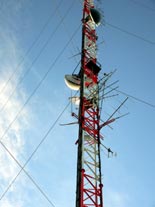
The tragedy of 9/11 nudged GPS tracking into the future, particularly GPS technology in cell phones. At that time, calls from a cell phone could not be tracked, which made locating victims and rescue workers more difficult. As a result, the federal government mandated that by the end of 2005, all cell phones must include the capability of being traced within 100 meters.
(Browse all the other GPS articles and features.)
Cell phone carriers responded by placing the GPS information in the phones themselves, giving the world the new capability of GPS cell phone tracking–but initially only when a 911 call was transmitted. This new capability was termed E911.
Since that time, however, the GPS chips in phones have been used to track people in all types of situations. Parents use it to track children and disobedient teens. Employers use it to monitor employees who work away from the home base. Men and women use it to follow or detect a possibly unfaithful significant other.
See the GPS Cell Phone Tracking
example in the video below
click the triangle to play
Tracking someone using cell phones, however, is not the same as the hand-held devices used in hunting or hiking. The majority of cell phones do not permit the user to access the GPS information. The user must go through a wireless network. Also, the GPS element in the phone must be enabled; the phone needs to be with the right network and on the right service plan.
How to get cell phone tracking
So, how does begin to set up GPS cell phone tracking? First, determine which wireless carriers provide the best coverage in the area needed, and the best type of communication per the user’s needs. Next, find the right phone to go with that carrier. Third, select the service plan to enable GPS tracking that best suits the user’s needs. Currently, T-Mobile, Cingular and AT&T provide the largest area of coverage. Nextel and Sprint have the most flexibility in communications. To illustrate, consider the following tracking systems:
- TrimTrac Mobile: TrimTrac Locator sends information to the user’s cell phone via SMS message. Tri-Band GSM and local SIM allow use globally. Cell phone uses WiFi internet, Microsoft Windows Mobile 5.0, and MapPoint.
- Mologogo: Free tracking service with any Nextel phone with Java, GPS, and a data-plan. Real-time location.
Within these plans are several options for the type of tracking required, and how the tracking data is transmitted. One available tracking option is called Geo-fencing. GeoFencing is a feature which tells the cell phone to start tracking only when it enters or exits a certain pre-specified area. When this occurs, the user can set up an option to receive an alert, either via email or text message. GeoFencing isn’t a constant type of tracking, but allows the user to track someone only when they are away from home, school, or the office.
Real-time GPS cell phone tracking
Other options include real-time GPS locating. With this option, the user can track someone on their computer via the carrier’s website in real time. For example, Jane’s mother is concerned about her driving alone to college some 200 miles away. Via this option, Jane’s mother can watch her daughter’s progress on her personal computer as a small blip moving along a map.
Employers can utilize GPS phone tracking to keep track of employees. While some of this may sound like an invasion of privacy, this option can improve performance, reduce waste and improve safety for workers. Consider construction workers or outside salespeople who are constantly away from the home base.
By issuing GPS cell phones to the workers, the employer can keep track of these workers and render aid more quickly in the event of an accident, illness, a vehicle breakdown, or if the worker simply needs directions. As with the mother tracking her daughter, this option provides real-time location on a map, so if necessary the employer can find any worker at any point in time.
Speed alert
Another option offered by carriers is called a Speed Alert. This feature alerts the user via email or SMS (Short Message Service) message when pre-set speeds are exceeded.
Most GPS phone tracking plans offer alerts via email or SMS messages to phones or specified websites. Cell phone to cell phone tracking, however, is also available. With this feature–much like “He’s heading for the bridge” in a movie chase scene–one cell phone user can track another via the carrier’s wireless network.
When tracking an individual, maps and mapping products are usually not provided by the carrier, but bought from other companies. A popular mapping product is Mapquest, which can produce maps anywhere in the world. Microsoft MapPoint and Tiger are also popular. When deciding on a carrier, check which maps they use, and what countries they are licensed to use them in. Mapquest shows maps all over the world, but the carrier may only be licensed for the United States.
What GPS cell phone tracking costs
The last point, and possibly the most important to consider is that of cost. As with other cell phone service plans, costs can include: the phone, activation and set up fees, and cost of the subscription plans. In addition, the wireless provider may levy a charge each time a location report is prepared, or may provide a certain number of reports per month with extra charges for those over the monthly limit. AccuTracking GPS cell phone tracking offers a “starter kit” for $99. The monthly fee on top of that is $5.99 plus the data plan making it $16.49 a month.
Overseas tracking (if available) may also produce an additional charge. Before purchasing and setting up a GPS cell phone tracking service, be sure to investigate all costs, fees, and limitations of the service.
See related information at Free GPS Cell Phone Tracking.